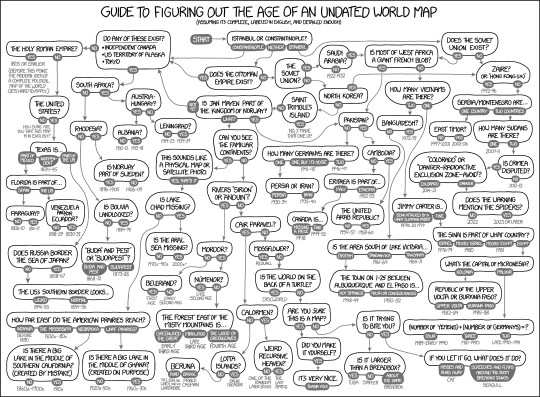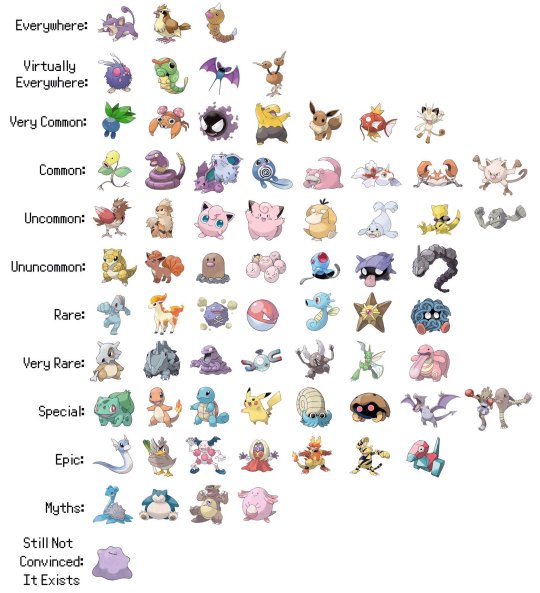Don't wanna be here? Send us removal request.
Photo

Guide to Figuring out the Age of an Undated World Map.
252K notes
·
View notes
Photo

Steven Jensen. Smoke from the demolished power plant forms a human-like figure. 2016
[::SemAp Twitter || SemAp::]
16K notes
·
View notes
Photo

The Internet’s Undersea World
From telephone poles suspending bundles of cable to signs posted warning of buried fiber optic lines, we are surrounded by evidence that at a basic level, the Internet is really just a spaghetti-work of really long wires. But what we see is just a small part of the physical makeup of the net. The rest of it can be found in the coldest depths of the ocean.
Ninety-nine percent of international data is transmitted by wires at the bottom of the ocean called submarine communications cables. In total, they are hundreds of thousands of miles long and can be as deep as Everest is tall. The cables are installed by special boats called cable-layers. It’s more than a matter of dropping wires with anvils attached to them - the cables must generally be run across flat surfaces of the ocean floor, and care is taken to avoid coral reefs, sunken ships, fish beds, and other ecological habitats and general obstructions. Cables located at shallow depths are buried beneath the ocean floor using high pressure water jets. Though per-mile prices for installation change depending on total length and destination, running a cable across the ocean invariably costs hundreds of millions of dollars.
The good news is that it’s hard to cut through a submarine communications cable, if only because of the thousands of very lethal volts running through each of them. The bad news is that it is possible, as seen in Egypt in 2013. There, just north of Alexandria, men in wetsuits were apprehended having intentionally cut through the South-East-Asia-Middle-East-West-Europe 4 cable, which runs 12,500 miles and connects three continents. Internet speeds in Egypt were crippled by 60% until the line could be repaired.
There are well over a thousand satellites in orbit. Surely satellites would be better than a technology invented before the invention of the telephone, right? As it turns out, no. (Or at least, not yet.) Though fiber optic cables and communications satellites were both developed in the 1960s, satellites have a two-fold problem: latency and bit loss. Sending and receiving signals to and from space takes time. Meanwhile, researchers have developed optical fibers that can transmit information at 99.7% the speed of light. For an idea of what the Internet would be like without undersea cables, visit Antarctica, the only continent without a physical connection to the net. The continent relies on satellites, and bandwidth is at a premium, which is no small problem when one considers the important, data-intensive climate research underway. Today, Antarctic research stations produce more data than they can transmit through space.
As of 2015, there are 285 communications cables at the bottom of the ocean, and 22 of them are not yet in use. Submarine cables have a life expectancy of 25 years, during which time they are considered economically viable from a capacity standpoint. Over the last decade, however, global data consumption has exploded. In 2013, Internet traffic was 5 gigabytes per capita; this number is expected to reach 14 gigabytes per capita by 2018. Such an increase would obviously pose a capacity problem and require more frequent cable upgrades. However, new techniques in phase modulation and improvements in submarine line terminal equipment have boosted capacity in some places by as much as 8000%. The wires we have are more than ready for the traffic to come. Sources [x x]
144 notes
·
View notes
Text
Victory is never punished. Nor will be The Trump Way.

In baseball, each November and December, a host of teams immediately start copying whatever the World Series winner did. It doesn’t matter what their philosophy was a few short months before. Upon the crowing of a new champion, teams will be described as doing things “The Cubs Way” or “The Royals Way” or “The Giants Way.”
Maybe it’s about relying on a stacked bullpen. Maybe it’s about tearing things down and building around cost-controlled superstars drafted as a result of the team tanking for a couple of seasons. Maybe it’s about mid-priced veterans, defense up the middle or “Moneyball,” whatever form it is being said to take in any particular year. It doesn’t matter what is is, really. Once someone is successful in baseball, a dozen or more teams will attempt to ape what they did for the simple reason that it worked. Some will win with their aped approach, some won’t. But coaches and executives from the successful teams will fan out across baseball and exert influence on organizations who want to do what they did. People will play follow-the-leader because everyone wants to be the leader and what better way to become one than to emulate that which is successful?
Neither you nor I know what caused the debacle that was last night’s election. Not definitively, anyway. We can certainly all point to the many factors which contributed to this horrible set of events, but we cannot and should not point at any one thing and say “That! That is to blame!” for America giving the presidency for the person least fit to hold it in our 240-year history. Most competing explanations for what happened last night are not mutually exclusive anyway. Most disasters are born of multiple causes and multiple failures. It will take years to truly sort out which factors were the most significant and even longer to truly cope with them. In the meantime all we can do is seek to limit the damage and work to put our nation back on a path that leads us forward as opposed to backward or, as I most fear, off the path entirely.
What we cannot do is sit back and pretend that what America did to itself on November 8, 2016 is of no consequence. Or that, however radical it may seem to us tonight, a good and happy normality will shortly resume and forever endure because, hey, we’re America and things always go OK for America. We cannot believe that, whatever brand of unhinged and dangerous leadership Donald Trump proposes to embark upon, that his party or our leaders or our system of checks and balances will rein him in or offset his excesses. To believe that is to ignore the essence of power and the thirst of those who crave it to drink of others’ success as a means of achieving it for themselves.
There is a sizable contingent of Republican politicians, activists and pundits who joined the so-called “NeverTrump” movement when our president-elect neared the nomination early this year. They said that, because Donald Trump does not share the principles of the Republican Party and because he was manifestly lacking in temperament to be President, they would not support him despite the fact that he was their party’s nominee. Some held that stance more steadily than others but, for the most part, the “NeverTrumpers” refused to significantly aid Trump’s campaign. At least beyond attempting to tear down Clinton’s candidacy, which proved irresistible to them, but that’s another matter.
As the campaign wore on, I suspected that the NeverTrumpers’ ability to, more or less, stick to their guns and not fall in behind Trump as a matter of party loyalty was based less on principle, however, than it was based on opportunism. They presumed, as did everyone except for Trump’s hardcore followers, that Trump would lose and lose badly. Associating with him and his presumed failure would be a bad strategic play. The 2020 election was already beginning for these people, and (a) getting a jump on opposing Clinton’s first term priorities; and (b) choosing the strongest horse to challenge her in four years was the top priority.
That’s all out the window now. We stand on the brink of four years of Donald Trump in the Oval Office and a Republican Congress at his disposal. This, I predict, will be too tempting an opportunity to pass up for Republicans who, until last night, claimed that Donald Trump had hijacked their party and did not speak for them.
In the coming weeks and months you will see a beeline of Republicans making the pilgrimage to Trump Tower to attempt to, at the very least, mend fences with our next president. More will baldly seek to join his administration. They will suffer a most curious amnesia about what it was that bothered them about him, his character, his rhetoric and, to the extent he articulated them, his policies. The portions of the GOP establishment who cried “Never Trump” yesterday will begin to fall in line this morning, if they haven’t reached out already.
But it will get worse than merely fence-mending. The total transformation of the Republican Party into the Donald Trump party began as soon as the race was called last night. The party which, for 160 years, has served as a mainstream opposition party to the Democrats through various realignments, wars, recessions and crisis, will embark upon The Trump Way. The lure of his power – always self-proclaimed, but now legitimate – will prove to be too great.
Victory, in politics as in sports, is never punished. it is emulated. The party leaders and pundits who cringed at Trump’s playbook, such as it was, will now swiftly embrace it for the simple reason that it worked. No one thought having three closers was necessary until the Kansas City Royals did it, but then a bunch of teams tried to do it too. Likewise, no one thought that running a campaign of bald-faced lies and projection, misogyny, bullying, appeals to white nationalism and the demonization of immigrants and minorities would work either, but lo and behold it did.
The NeverTrumpers in the GOP will not bend Donald Trump to their will or even to some semblance of identifiable normality compared to past presidents. He will do what he has always done: pointed at his success, real or imagined, but in this case very real, and dare someone to tell him why he should change. None to whom he’d even consider listening will even dare to do so. Just as several teams tried to stack their bullpen the way the Royals did after 2014, the GOP will adopt The Trump Way. In a world where power and victory are all that matter, the argument against doing so will seem nonsensical.
A darkness fell upon America last night. It will get darker still, because it will be irresistible for so many to embrace the dark.
Follow @craigcalcaterra
16 notes
·
View notes
Photo
It’s kind of amazing that only 1 player on the current Cubs’ roster has been with the organization for over five years (and only 2 of them pre-date Theo’s arrival).

http://flipflopflyin.com/flipflopflyball/info-2016cubsroster.html
14 notes
·
View notes
Photo

1992-2016.
(img via Allison WIlliams twitter)
1 note
·
View note
Photo










Watch: This unbelievably intense supercut shows ‘Mad Max: Fury Road’ without the CGI
Follow @the-future-now
3K notes
·
View notes
Photo

Peak viewing times for fall colors across the contiguous United States.
10K notes
·
View notes
Video
instagram
Ken Griffey Jr.’s Hall of Fame induction suit and tie
38 notes
·
View notes
Photo
A Ponyta popped up on my screen while I was driving, and I chose not to wreck my car to trying to catch it. It was (probably) the right choice.

22K notes
·
View notes
Photo

Which Shakespeare Play Should I See?
This coming Saturday is the 400th anniversary of Shakespeare’s death! Not sure what Shakespeare play you should see or read to commemorate the occasion? No worries! I’ve put together a little flowchart to help you make up your mind.
HAPPY SHAKESPEARE-ING, EVERYONE!
12K notes
·
View notes
Photo

Did you ever lose something, then stumble upon it years later in an obvious place?
Neil Gaiman drew this sketch for me in 1993. I thought I’d lost it a decade or so ago in a move. This past week, I went to re-read my copy of American Gods; the sketch was hiding inside.
2K notes
·
View notes














